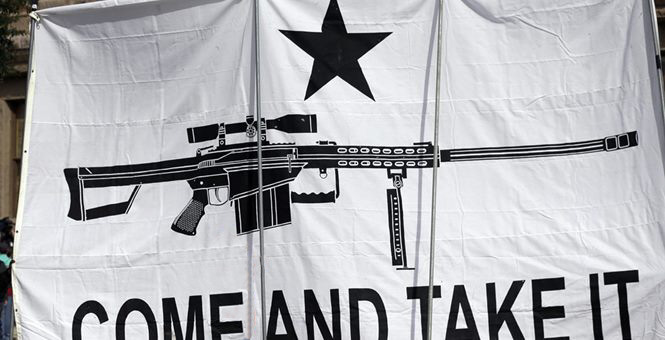

Progressive's Use of Hypotheticals
Illustrated by LA Times Article

By Dean Weingarten. March 2, 2020
Article Source
(Ammoland.com)- Many of the proposals of those who want a disarmed society are founded in wishful thinking. Hypothetical examples, based on false assumptions about the nature of reality, are put forward as if they are fact. One of the most blatant and one-sided examples of this was recently published in the Los Angeles Times.
The title of the piece is How many mass shootings might have been prevented by stronger gun laws?, by Rahul Mukherjee, on 26 February 2020.
The article lists five types of restrictive gun laws and considers how they might have stopped 167 mass killings over the last 64 years.
The author appears to violate the rules of his own game.
Here are the five types of restrictions on gun ownership the author considered:
1. A ban on straw purchases.
The author lists five cases where people made straw purchases for someone else. The other person then committed mass murder. But straw purchases were illegal for all of the periods where the five examples occurred.
The one example is given, that of the Columbine High School killers resulted in prison sentences for the two people who committed straw purchases for the Columbine killers.
It is hard to imagine the crimes would have been prevented when the law was already in effect, and the crimes were *not* prevented.
2. Safe Storage Requirement, where guns would be required to be kept locked up when not in use.
The example given was of a 20-year-old adult security guard, who was blocked from purchasing a semiautomatic weapon, then committed mass murder with his father's firearms. It seems unlikely a lock on a box would have been sufficient to keep him from taking his father's firearms. There are several cases where people who committed mass murder stole the firearms they used. The LA time article refers to the 20-year-old adult security guard as an "underage shooter".
3. 'Assault weapons' ban.
The article claims 38 mass murder events could have been prevented, including 6 which occurred during the federal "assault weapons" ban. It uses as an example, the rifle used in the Sandy Hook mass murder. But there already was an existing Connecticut 'assault weapons' ban, passed in 1993, expanded in 2001. Most of the mass murders in the database, 129 of 167, according to author Mukherjee, would not have been affected. There is little reason to suppose a substitution of weapons would not have occurred in the other 38. In the Sandy Hook case, the murderer, after murdering his mother, had access to numerous other weapons as well as the rifle he used.
4. Mandatory background checks (presumably a ban on private sales).
In yet another case of existing law failure, the author uses as an example the Charleston church murders from 2015. A background check was performed on the murderer, but the information that he was prohibited had not been reported to the FBI.
5. Red flag law
The author claims 141 of the 167 cases could have been prevented if Red Flag laws were in place. Then he gives another example of where existing laws were ignored. He uses the Stoneman Douglas school mass murder.
There were numerous times where interventions could have occurred to prevent those murders, without "Red Flag Laws".
The author does not explore how many failures of existing law occurred in other cases.
Hypothetical examples or fantasies, such as the ones pushed in the article are not useful in formulating policy. They are not based on fact, but on wishful thinking.
If we are to deal with hypothetical potentials, we may as well consider what would have happened if the victims in those mass killings had been armed. The events would almost certainly not have been mass killings. Most mass killings occur in places where the victims are not allowed to be armed. Every one of the five mass killings highlighted as examples in the LA times article occurred where none of the victims were armed.
Armed victims or armed Samaritans have stopped mass murder in numerous cases, at least two dozen.
The officers who shot back at Columbine were not killed.
In the Stoneman Douglas mass murders, the armed police officer ran outside the building and did not attempt to intervene, leaving the victims defenseless. He survived and is facing charges.
Most people who push for restrictions on firearms have the fantasy of a future without firearms.
Just consider the hypothetical "if there were no guns".
It is a fantasy. Homemade guns are made on every continent except, possibly, Antarctica. Mass murders were committed long before guns were invented.
Without guns, the weak are subservient to the strong.
The author ignores the Second Amendment and Constitutional problems with their hypothetical fantasies.
A comparable hypothetical would be a law to forbid media from excessive reporting of mass murders, which is widely believed to trigger more mass murders with media contagion.
The United States has become the most powerful and most prosperous nation on earth, in large part because government power is limited.
Destroying the limits on government power will create far more problems than it will solve
About Dean Weingarten:
Dean Weingarten has been a peace officer, a military officer, was on the University of Wisconsin Pistol Team for four years, and was first certified to teach firearms safety in 1973. He taught the Arizona concealed carry course for fifteen years until the goal of Constitutional Carry was attained. He has degrees in meteorology and mining engineering and retired from the Department of Defense after a 30-year career in Army Research, Development, Testing, and Evaluation.
![]()

























